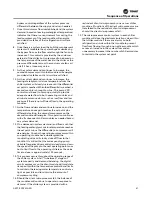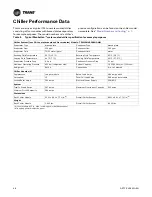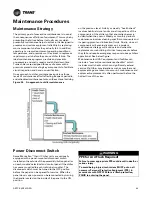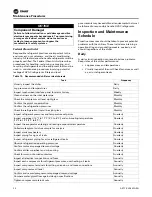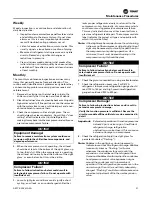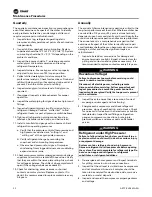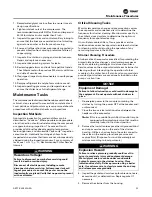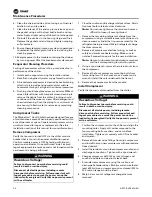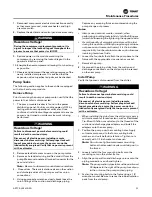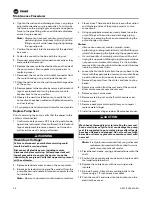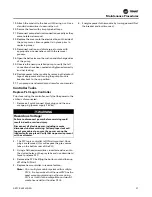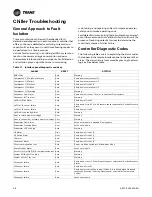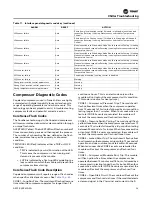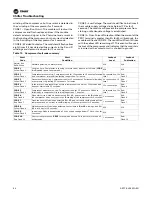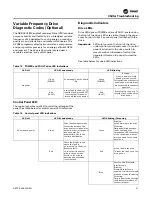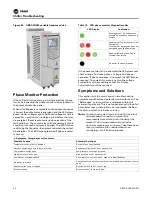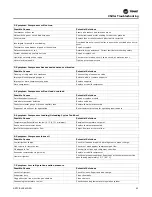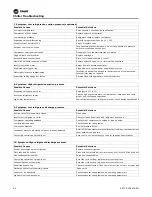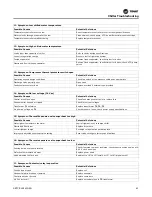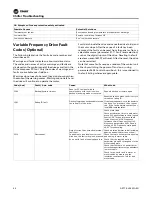
Maintenance Procedures
ARTC-SVX002A-EN
53
7. Record water/glycol mixture flow to ensure it meets
design specifications.
8. Tighten rotalock nuts at the compressors. The
recommended torque is 80 lbf for 2 inch and larger and
60 lbf for rotalock nuts smaller than 2 inch.
9. Inspect all copper lines and control capillary tubing to
ensure that the lines are separated and not vibrating
against one another or the frame or housing.
10. Ensure all refrigeration lines are properly supported to
prevent vibration from causing premature failure of
copper piping.
11. Inspect all insulation on piping and control sensors.
Repair and replace as necessary.
12. Inspect entire plumbing system for leaks.
13. Review logged alarms and look for repetitive trends.
The chiller can retain the previous 200 alarms with time
and date of occurrence.
14. If equipped, inspect crankcase heaters to verify proper
operation.
15. Sample refrigerant to analyze for moisture or acid.
16. Inspect operating pressures and temperatures and
ensure the chiller has a full refrigerant charge.
Maintenance Tasks
The maintenance tasks described herein present the basic,
minimal, steps required to successfully complete a task.
Local policies and protocols may require more elaborate
procedures with additional checks and inspections.
Inspection Methods
Appropriate inspection for modern chillers can be
described as “hands on.” Where possible and appropriate,
visual inspection should include touching the component
or apparatus being inspection. The sense of touch
provides additional feedback regarding temperature,
texture, tightness, and dryness that “eyes only” inspection
cannot match. Habitually touching each item to be
inspected also ensures that items are not subconsciously
skipped during the inspection process. For a summary of
tasks, see
, Recommended Chiller Service
Intervals.
Critical Cleaning Tasks
Monitor temperature change and pressure drops across
the evaporator and condenser circuit to determine the
frequency for strainer cleaning. Monitor water quality in
the chiller’s closed system to determine the optimum
frequency for evaporator cleaning.
On multiple module chillers, Trane provides service
isolation valves on each evaporator to isolate each strainer
for cleaning without disrupting the operation of any
remaining modules in the chiller.
Strainer Cleaning Procedure
Strainers at each evaporator are critical for protecting the
brazed plate heat exchanger’s small water passages as
well as maintaining water/glycol mixture cleanliness.
Service valves on the evaporator isolate each strainer for
cleaning without interrupting the operation of other
modules in the chiller bank. If a tank and pump module is
provided, pot strainers are occasionally included on the
pumps’ suction lines.
1. De-energize power to the module containing the
strainer by turning the power OFF at the breaker and/
or disconnect.
2. Close the two service isolation valves between the
header and the evaporator.
Note:
If this is a variable flow chiller, the outlet may be
equipped with an electronic valve that must be
manually locked in the closed position.
3. Remove the insulation to expose the roll grooved blind
end cap or service cap on the end of the strainer
housing. Utilize a short section of hose to connect to
the valve on the end cap to relieve pressure and
capture fluid. (Dispose of or re-utilize water/glycol
mixture according to local protocols.)
4. Inspect the gasket and service cap for abrasions, tears,
excessive dirt, or deterioration. Replace gasket if
necessary.
5. Remove the strainer from the housing.
WARNING
Hazardous Voltage!
Failure to disconnect power before servicing could
result in death or serious injury.
Disconnect all electric power, including remote
disconnects before servicing. Follow proper lockout/
tagout procedures to ensure the power can not be
inadvertently energized. Verify that no power is present
with a voltmeter.
NOTICE
Equipment Damage!
Failure to follow instructions could result in damage to
the equipment. Do not operate without strainers in
place.
WARNING
Explosion Hazard!
Failure to relieve pressure gradually could result in
minor to moderate injury and equipment damage.
Water/glycol mixture can be under considerable
hydraulic pressure in the strainer housing. Close
isolation valves fully. Relieve pressure using a boiler
vale. Use extreme care to slowly remove the end cap
and release pressure gradually.









